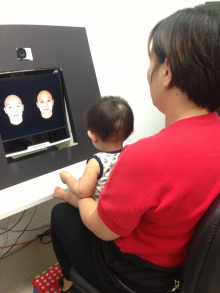Media
Psychologists at HKU say the effect from infant multi-sensory learning “depends”
09 Sep 2015
Tactile books, building blocks and baby Beethoven CDs are just some of the many things commonly found in homes of newborns. Parents now start their child’s skill building and brain-boosting process earlier than ever, given the competitive nature of preschool placements, “elite” playgroups and baby gyms. However, are all learning tools equally beneficial?

A HKU baby scientist sits on her mother's lap and watches visual
figures displayed on the monitor while HKU researchers monitor their
eye movements to decode their understanding and preference of the
world.
Researchers from the Psychology Department of the University of Hong Kong (HKU) say the answer to this parenting maze depends. The HKU Infant Research Lab, led by Assistant Professor Dr. Chia-huei Tseng, conducted experiments that involved tracking the eye movements of 8-10 month old infants as they viewed clips comprising of images of facial expressions and auditory voices conveying emotions.
The research results, published in August in one the flagship psychology journals, Developmental Science, show that infants could learn basic abstract rules, such as sequences, when both the audio and visual stimuli were presented simultaneously, but not when they were presented alone. Extrapolating the research results into the real world, we can believe that babies can learn better from books that come with interactive sound elements, compared to just picture books or baby audiobooks.
This is not completely surprising, given that when redundant information is conveyed by more than 1 of our 5 senses, we have a greater chance of successfully encoding it in our memory, allowing us to learn more effectively. However, additional studies led the HKU researchers to conclude that this view is over-simplified.
They also discovered that infants can only learn the same abstract rule when the audio and visual stimuli were “congruently” or “consistently” paired. If a smiling face was paired with a crying sound, the infants were confused, and did not learn the rule. In other words, having both visual and audio inputs does not guarantee successful learning – they have to match the nature of each other.
This finding that preverbal babies possess the capacity to integrate audio-visual emotions (e.g. they know that a happy voice should be paired up with a smile, while a sad voice should be paired up with a frown) has additional implications for parents. Infants can sensitively detect any inconsistent emotional expressions from caretakers, such as a fake smile combined with an angry tone, and may feel cognitively disorganized. This confusion could lead to less effective learning when new things are presented to them.
This suggests the common belief that “multi-sensory stimulation promotes infant development and learning” is not always true. The key to helping our little ones fully benefit from it is the way we combine stimulation from visual, audio, tactile, and other sensory systems into a unified manner.
A brief video interview of the study abstract is available (English) (3’54”):
https://www.youtube.com/watch?v=KYTyjH1k9RQ
To interview Dr Tseng Chia-huei or for queries about the research and infant learning behaviour, please contact Dr Tseng at the Department of Psychology at 3917-8043 or [email protected].
For press enquiry, please contact:
Ms Trinni Choy (Assistant Director (Media), Communications and Public Affairs Office) tel: 2859 2606 / email: [email protected] or Ms Melanie Wan (Senior Manager (Media), Communications and Public Affairs Office) tel: 2859 2600 / email: [email protected]; or Ms Rhea Leung (Manager (Media), Communications and Public Affairs Office) Tel: 2857 8555 email:[email protected].
